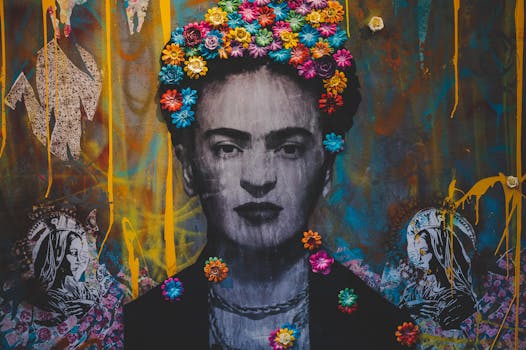Frida Kahlo: The Iconic Mexican Painter

Frida Kahlo remains one of the most recognizable and influential artists of the 20th century. Her deeply personal and often surreal paintings offer a glimpse into her tumultuous life, marked by physical pain, emotional suffering, and an unyielding spirit. Born in 1907 in Coyoacán, Mexico, Kahlo's work transcends cultural boundaries and continues to inspire generations. This article explores various facets of her life and art, delving into her unique style, personal struggles, cultural impact, and enduring legacy.
Early Life and Influences
Frida Kahlo was born Magdalena Carmen Frida Kahlo y Calderón to a German father and a mestiza mother. Her early years were marred by illness; she contracted polio at the age of six, which left her with a limp. Despite these challenges, Kahlo displayed a keen interest in art from a young age. She attended the National Preparatory School in Mexico City, where she mingled with future political luminaries and began to shape her artistic vision.
One of the most significant influences on Kahlo's work was her tumultuous relationship with fellow artist Diego Rivera. The two married in 1929, beginning a lifelong partnership that was as passionate as it was volatile. Rivera's encouragement helped Kahlo develop her unique style, characterized by vibrant colors and symbolic imagery rooted in Mexican folk culture.
Her early paintings often depicted still lifes and self-portraits, reflecting her fascination with Mexican culture and identity. These themes would become central to her work as she sought to express her personal experiences through art.
The Accident That Changed Everything
In 1925, at the age of 18, Frida Kahlo was involved in a bus accident that would alter the course of her life. She sustained severe injuries, including fractures to her spine, pelvis, and ribs. During her long recovery period, Kahlo turned to painting as a means of coping with her physical pain and emotional turmoil.
Confined to bed for months, she created some of her most iconic works during this time. Her self-portraits from this period reveal a raw introspection and vulnerability that resonate deeply with viewers. In these paintings, she frequently depicted herself with symbols of pain and suffering, such as thorns or surgical instruments.
This accident not only influenced Kahlo's subject matter but also reinforced her commitment to portraying the female experience authentically. Her work challenges conventional notions of beauty and femininity, offering a candid exploration of the human condition.
Artistic Style and Themes
Frida Kahlo's artistic style is often described as surrealist, though she herself rejected this label. She preferred to call her work "magical realism," emphasizing the blend of fantasy and reality that characterizes much of Latin American art. Her paintings are rich in symbolism and draw heavily from Mexican folk traditions.
Common themes in Kahlo's work include identity, postcolonialism, gender, class, and race. She frequently incorporated elements from pre-Columbian Mexican culture into her paintings, such as indigenous clothing or mythical creatures. This fusion of personal and cultural identity is evident in pieces like "The Two Fridas" (1939), which depicts two versions of herself—one dressed in traditional Tehuana attire and the other in European clothing.
Kahlo's use of vibrant colors and intricate details further enhances the emotional impact of her work. Each painting tells a story that invites viewers to explore the depths of human experience through the lens of Kahlo's unique perspective.
Legacy and Cultural Impact
Frida Kahlo's influence extends far beyond the art world; she has become an enduring symbol of resilience and empowerment. Her unapologetic portrayal of pain and suffering resonates with people across different cultures and generations.
Kahlo's legacy is particularly significant within feminist circles. She is celebrated for challenging traditional gender roles and advocating for women's rights through her art. Her self-portraits serve as powerful statements on body image and self-acceptance—a message that remains relevant today.
The Frida Kahlo Museum in Coyoacán—also known as La Casa Azul (The Blue House)—attracts thousands of visitors each year who come to see where she lived and worked. This museum offers an intimate look at Kahlo's life through personal artifacts, photographs, and some of her most famous paintings.
Kahlo’s Influence on Modern Art
Kahlo’s impact on modern art cannot be overstated. Contemporary artists continue to draw inspiration from her bold use of color, emotive storytelling techniques, and unflinching honesty about personal struggle. Her ability to blend political commentary with deeply personal narratives has set a precedent for future generations of artists looking to make meaningful statements through their work.
- Kahlo’s use of symbolism has influenced modern surrealist artists.
- Her emphasis on cultural identity continues to inspire Latin American artists.
- The feminist themes in her work remain relevant in discussions about gender equality in art.
| Aspect | Details |
|---|---|
| Birth | 1907 in Coyoacán, Mexico |
| Main Influences | Mexican folk culture, Diego Rivera |
| Main Themes | Identity, Pain, Feminism |
| Museum | La Casa Azul |
Frida Kahlo’s life was one marked by tremendous pain but also immense creativity and strength. Through her art, she communicated complex emotions and ideas that continue to resonate with audiences today. From exploring themes like identity and gender to drawing inspiration from Mexican culture, each piece she created offers something profound for viewers to ponder.
Kahlo’s legacy endures not just through her paintings but also through the countless people she has inspired across different fields. Whether you are an artist seeking inspiration or someone looking for stories of resilience, Frida Kahlo’s life serves as a powerful testament to human endurance and creative expression.